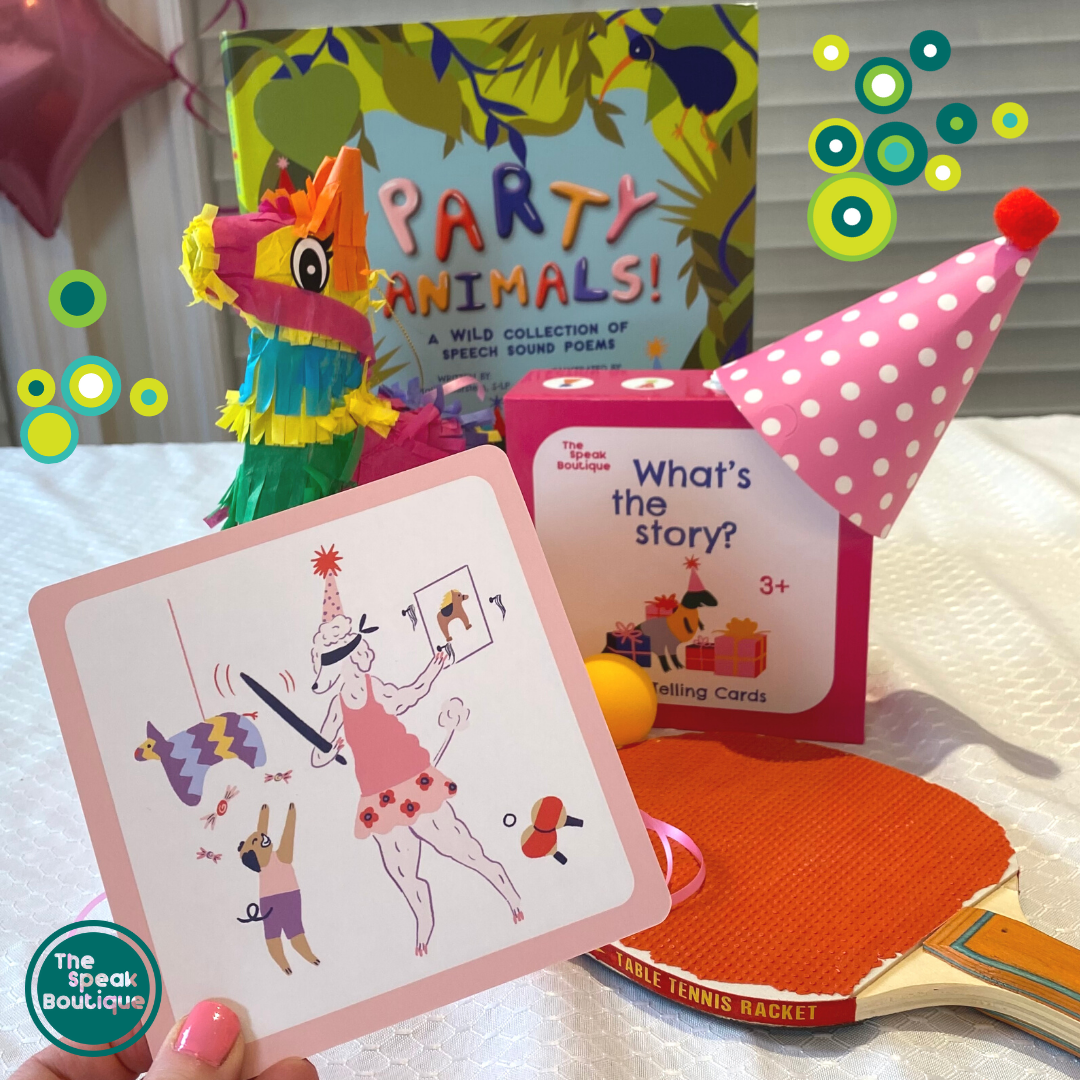
Party Puppy’s Target Roundup
Party Puppy’s Target Roundup

Every fun and playful story, poem and character in The Speak Boutique’s product line is loaded with speech and language enriching opportunities. Here are just a few suggestions from Party Puppy.
Speech:
The Party Puppy poem in Party Animals! is loaded with the /p/ sound in words such as puppy, poodle, party, polish, pink, purple, pompom, poppy etc.). Use for fun tongue twister-like practice of saying /p/, and also auditory bombardment/modelling of /p/. These sound-loaded scenes offer generous practice opportunities for children with motor speech disorders, articulation difficulties, and fluency concerns. Pair with the lips-together card from What’s that Sound? Speech Sound Cards to help children see what part of their mouths move (in this case it’s lips) to make this sound.

Sample Party Puppy Speech Therapy Plan:
1. WARM UP: Use the “Sound it” cards from What’s that Sound? Speech Sound Cards to do a quick drill of the sound/movement you’re working on (Party Puppy of course lends itself to /p/ PROMPT trained S-LPs will appreciate the word puppy for alternating planes of movement. ) or make up a silly story with the images on the card.
2. STORY: Read the Party Puppy poem from the Party Animals! book. The poem is intentionally repetitive to offer ample opportunities for practice. This is particularly important for children with motor speech disorders such as childhood apraxia of speech, who benefit from more repetition of fewer targets. If you are an S-LP working with a child who has a phonological disorder and are using the cycles approach, you can use the “Sound it” card from What’s that Sound? Speech Sound Cards and/or the poem from the Party Animals! book for auditory bombardment.
3. SEQUENCING/STORY RETELL: Use the corresponding cards from the What’s the Story? Story Telling Cards to sequence or retell the story.
4. GAME TIME: Many puppy games will complement this session, one I love is Puglicios by Mattel because it’s so adorable and motivating, TONS of opportunities for repetition and it coordinates so well with the story: pug + pepperoni ? Perfect!!! Did you know that I am currently designing a board game to compliment the rest of the products at The Speak Boutique? Follow me @TheSpeakBoutique on Instagram or join Tali’s Party Animals! Community on facebook for up do date announcements!
5. HOMEWORK: Check out the Party Animals! Speech Sounds Activity Sheets - Digital Download for additional for additional home practice.

Language:
Puppy’s story can be found in both the Party Animals! book and What’s the Story? Story Telling Cards. In both instances, children can narrate and describe what they see in the images. Using the cards, children can sequence and/or retell Puppy’s story. There are also several opportunities for inferencing in these cards. E.g. Children can answer:
Why is poodle painting her nails? Is puppy careful? Whose party is she going to? What do you think is in the present? Was it a good gift? What are the clues that let them know? Teachers, S-LPs, CDAs and SLTs can expand on the party theme and make pop corn with the children you are working with. Use visuals to help them sequence the steps. Practice verb conjugation by feeding puppy each of her treats. (“Puppy eats/ate pizza, Puppy eats/ate popcorn, etc.).
In our recent presentation at the ASHA 2021 National Convention, Beth Poss astutely pointed out that games inherently target sequencing . They have a clear beginning & end, and obstacles to overcome in between. When working on language skills and sequencing with your students, you can also use games as a topic to generate discussion: what games do you like to play? Are there games your family plays together? Do you like to play games where you move around, or sit at a table?
Literacy:
Puppy’s photo is a good opportunity to discuss sounds vs. letters. We can point out to our students that although “photo” is spelled with a P the sound the P +H makes is very different. This is often an important discussion with parents as well - regardless of the sound you are working on. Parents will often say “we’re working on the letter [insert sound here].” Or appear confused when I put a word like “noisy” for Z practice. It’s important in speech sound disorders therapy to distinguish sounds vs. letters so we are on the same page.
A while back (Sept 2020), instagrammer @kiwispeech posted a grid I loved that she uses to delineate sound vs. letters and where they do/do not overlap. I adapted it for P in puppy here. In the top left quadrant the P sound can be spelled with one or two Ps, depending on the word, the bottom left quadrant the P combines with H to make a brand new sound: F. There isn’t a word – as far as I know - that uses a different letter to make a P sound, so that quadrant in blank, and the final quadrant shows a word that uses the letter F for that F sound. We can do the same thing for the F sound, and here I was able to fill all the quadrants.



Thank you Teresa! We were super happy to meet you at ASHA and are happy you enjoyed the post. Thanks for letting us know about the broken link. It should be corrected now.
The Speak Boutique on
After buying the whole set at ASHA, I’m finally able to take the time to see how to use these. When I clicked on the homework sheet, it came back that there was an error. This is the first blog post I have looked at, but I love the ideas!!
Teresa Garlick on